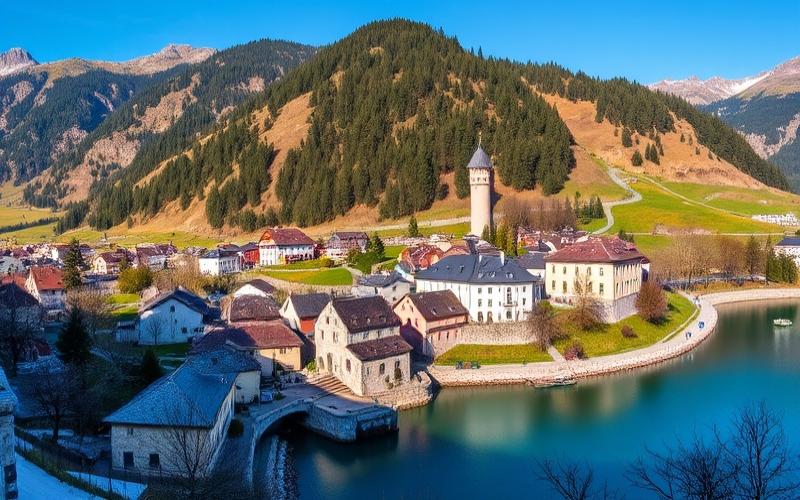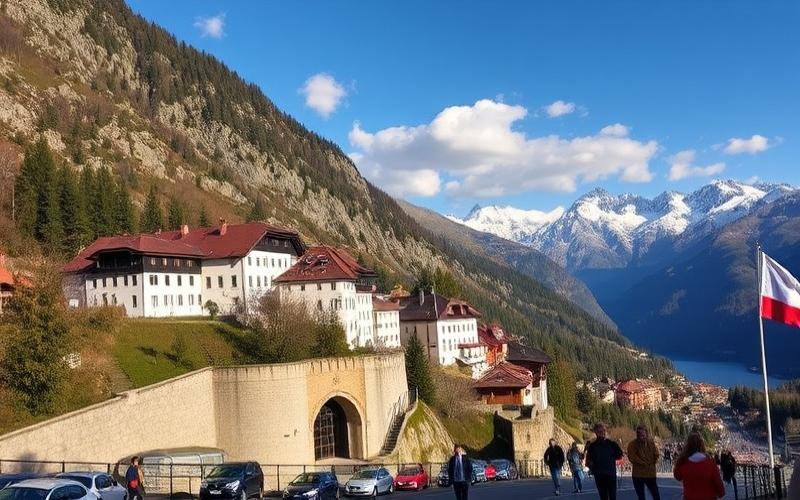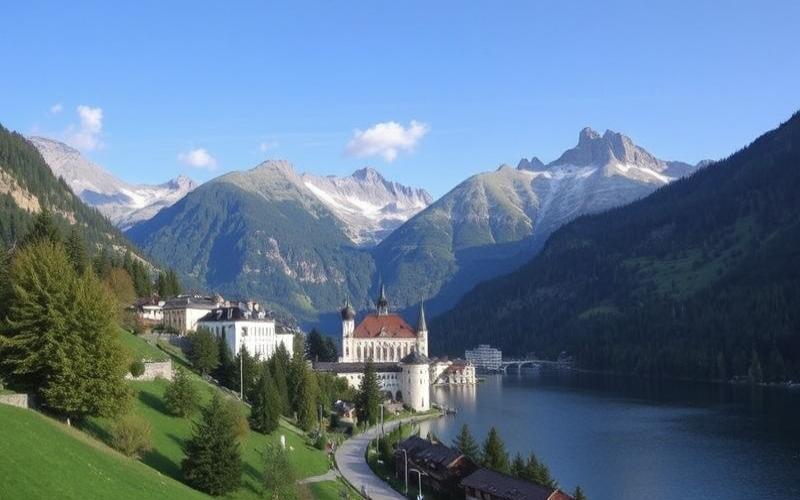
 Published on and written by Cyril Jarnias
Published on and written by Cyril Jarnias
Nestled Between Switzerland and Austria, the Tiny Principality of Liechtenstein
Nestled between Switzerland and Austria, the tiny principality of Liechtenstein holds a fascinating and little-known history, worthy of discovery for its wealth of singular events and political transformations.
From Medieval Origins to a Modern Financial Center
From its medieval origins within the Holy Roman Empire to its current status as a thriving financial hub and industrial innovator, Liechtenstein has preserved its independence and distinct identity despite the turmoil of neighboring Europe.
A History Marked by Strategy and Neutrality
Whether through strategic dynastic alliances, progressive 19th-century reforms, or its courageous commitment to neutrality during the World Wars, the history of this extraordinary country invites us to explore the narratives of a nation that pushes the boundaries of imagination.
Good to Know:
Liechtenstein is one of the few countries worldwide that has maintained political and dynastic continuity since the Middle Ages, with the princely family ruling since 1719.
Blending tradition and modernity with rare finesse, Liechtenstein remains a unique example of stability and innovation in Europe.
Origins: From Independent Tribes to the First Counts
Before the arrival of the Romans, the Alpine region that would become Raetia was inhabited by several tribes with diverse origins and influences. The Raetians were the main indigenous group, occupying a vast territory around the central Alps, from Tyrol to Vorarlberg and present-day eastern Switzerland. Their precise identity remains debated: some ancient authors attributed them Etruscan or even Illyrian origins, but it’s more likely they formed a confederation of Alpine tribes with their own linguistic and cultural affinities. Alongside them, other Celtic or Celticized groups occupied the Bavarian Alpine foothills (the Vindelici), as well as certain Alpine valleys where peoples related to the Celts had settled.
Major Tribes Before the Roman Conquest:
| Tribe/People | Main Location | Key Characteristics |
|---|---|---|
| Raetians | Central Alps (Tyrol, Vorarlberg) | Main Alpine people, confederation |
| Vindelici | Bavaria (Alpine foothills) | Neighboring Celtic group |
| Feltrini | Feltre Valley | Local group sometimes assimilated with Raetians |
| Tridentini | Trent Valley | Same |
The Roman conquest under Augustus in 15 BC, followed by the creation of the province of Raetia (or Raetia and Vindelicia), profoundly transformed the region. The Romans imposed their civil and military administration:
- Road construction to connect major towns.
- Urban foundation or development around pre-existing settlements.
- Gradual assimilation of local elites into Roman culture.
- Early Christianization, though limited in this peripheral region.
Roman influence manifested through partial Romanization: adoption of Latin in administration and commerce, introduction of Roman law, construction of public infrastructure like aqueducts and baths.
Germanic invasions from the 5th century onward disrupted this balance:
With the decline of Rome in the 5th century AD, the Alemanni began to penetrate Raetia en masse from the northeast. Roman defense quickly weakened against their repeated incursions; around 470 AD, the remaining garrisons abandoned their posts in the face of the Alemannic advance.
The Alemanni settled permanently in the already partially Romanized rural areas:
- Gradual replacement of Vulgar Latin by Germanic dialects.
- Profound social transformation, with a marked decline in urban structures in favor of a more decentralized rural society.
- Influence on local toponymy, still visible today in some place names.
From the High Middle Ages onward, several small autonomous lordships gradually developed, stemming either from a late administrative heritage (local heirs exercising residual power) or from a new feudal structure linked to territorial fragmentation following the Germanic invasions:
- Emergence of domains controlled by local nobles
- Gradual formation around castles
- Variable allegiance over time to various imperial sovereigns
- First written traces attesting to these micro-lordships from the 10th-11th century
These small territories often formed the initial basis on which counties and later principalities would be built.
Regional political development then took shape around two major entities that would play a key role in later forming what would become Liechtenstein: the counties and then directorial possessions associated with local feudal families were gradually consolidated under unified control through political marriages or successive purchases – a typical process throughout the late Middle Ages until the beginning of the classical modern Western European period when modern principality structures emerged etc…
An Illustrative Table Can Summarize This Territorial Evolution Up to Modern Liechtenstein:
| Period | Major Event / Structure |
|---|---|
| Before 15 BC | Raetian & Celtic-influenced tribes |
| 1st-3rd centuries AD | Province of Raetia: partial Romanization |
| 4th-6th centuries | Germanic invasions: Dominant Alemanni |
| 7th-12th centuries | Emerging medieval small lordships |
| 13th-18th centuries | Formal counties of Vaduz & Schellenberg/dynastic purchases |
Thus, by the 13th/14th century, the following officially appeared:
- The imperial county/fief known as the directorial domain “Vaduz”
- The noble domain callable “Schellenberg”
These two entities remained separately administered for several generations before a powerful dynasty finally united these titles under single control through a precise legal act – this was only achieved in the early 18th century thanks to a joint land acquisition made possible when Prince Johann Adam Andreas von Liechtenstein successively purchased Schellenberg (1699) then Vaduz (1712). This dual possession allowed for the establishment of a stable political entity immediately recognized by the Holy Roman Empire, giving birth to the modern principality named Liechtenstein.
Good to Know:
In Liechtenstein’s history, Celtic and Raetian tribes were the first inhabitants of the region before Roman influence established itself with the creation of the province of Raetia. This province left lasting traces in terms of infrastructure and culture. The Germanic invasions then marked a upheaval, with the domination of the Alemanni who gradually took over, integrating the region into their sphere of influence. In the Middle Ages, the political landscape evolved with the formation of small lordships that led to the first steps toward a comital structure, notably with the counties of Vaduz and Schellenberg. The latter played a crucial role in laying the political and territorial foundations for the establishment of Liechtenstein in the early 18th century. It is interesting to examine historical maps to visualize these transformations, revealing how fragmented territories became a coherent political unit.
Liechtenstein Through the Centuries: From the Roman Empire to the Counts of Hohenems
The influence of the Roman Empire on the present territory of Liechtenstein was marked by its integration into the Roman province of Raetia. This province, created in 15 BC, encompassed a vast region including eastern Switzerland, southern Germany, part of Austria, and northern Italy. Liechtenstein, located in this area, was integrated into the Roman province and experienced significant Roman military presence, with legionary camps to protect the region from barbarian invasions.
Archaeological traces of the Roman presence include Roman villas discovered in Schaanwald and Nendeln, as well as a fort erected in the 4th century to protect against Alemannic attacks. These remains testify to dense colonization and a lasting cultural legacy left by the Romans.
Transition Under the Alemanni and Integration into the Holy Roman Empire
After the fall of the Roman Empire, the territory was influenced by the Alemanni, a Germanic tribe that coexisted with Latin cultures for centuries. The region was then incorporated into the Carolingian Empire in 806 and became a Frankish county. In the 10th century, Raetia was ruled by the Counts of Bregenz, whose lineage died out in 1152. Subsequently, the region was divided into various counties.
Evolution Under the Control of Noble Families
The region experienced significant evolution under the varied control of noble families, notably the Counts of Hohenems. The latter played a crucial role in the socio-political formation of Liechtenstein by influencing territory management and participating in regional alliances and conflicts.
Influence of the Counts of Hohenems:
- Territorial control: The Counts of Hohenems exercised significant control over important territories in the region, allowing them to influence local political decisions.
- Alliances and conflicts: They were involved in regional alliances and conflicts, thus contributing to the complex evolution of the region over the centuries.
European Historical Context
Events in the Liechtenstein region unfolded within the broader context of European alliances and conflicts. For example, the establishment of the Principality of Liechtenstein in 1719 was influenced by the political structures of the time, notably the Holy Roman Empire. The region was also affected by wars and treaties that shaped Europe, such as the dissolution of the Holy Roman Empire in 1806, which led to Liechtenstein’s independence.
Key Events in Liechtenstein’s History:
| Event | Date | Description |
|---|---|---|
| Integration into the Roman province of Raetia | 15 BC | The present territory of Liechtenstein becomes part of the Roman province of Raetia. |
| Influence of the Alemanni | After 476 | The Alemanni coexist with Latin cultures in the region. |
| Integration into the Carolingian Empire | 806 | The region becomes a Frankish county. |
| Establishment of the Principality of Liechtenstein | 1719 | The principality is created by the union of Vaduz and Schellenberg. |
| Independence from the Holy Roman Empire | 1806 | Liechtenstein becomes independent. |
These events shaped the region and contributed to its unique development in the European context.
Good to Know:
The present territory of Liechtenstein was once part of the Roman province of Raetia, marking the considerable influence of the Roman Empire through archaeological remains such as ancient roads and columns testifying to Roman infrastructure. After the fall of the Empire, the Alemanni settled there, before its integration into the Holy Roman Empire, which saw the region evolve under the governance of various noble families. Among them, the Counts of Hohenems played a crucial role in the 17th century, contributing to the socio-political organization of the territory by shaping local laws and land management, at a time when European alliances and conflicts continually redrew local political boundaries.
A Prince-Bishop Tells You: The Era of the Holy Roman Empire
The prince-bishop, or Fürstbischof, embodied a unique figure within the Holy Roman Empire: he combined the spiritual role of a bishop with the temporal power of a prince. Endowed with sovereign rights granted by the Kings of the Romans from the central Middle Ages onward, these religious dignitaries became major actors in the political balance of the imperial territory. Their dual authority allowed them to sit in the Imperial Diet alongside secular princes and to actively participate in the political, cultural, and administrative life of their principalities.
Prince-bishops played a crucial role in the struggle between central imperial authority and the great princely dynasties. They often served as loyal allies to the emperor, who entrusted them with extensive prerogatives to counter the growing influence of powerful noble families. Among them, the prince-archbishops of Mainz, Cologne, and Trier stood out for their exceptional power: they participated in the election of the German king and later emperor and directly influenced major political decisions.
Their power was exercised both on religious and temporal levels:
- Religious power: Diocesan management, appointment of clergy, organization of worship.
- Political power: Territorial administration (justice, finances), participation in imperial assemblies (diet), alliances with other states.
- Cultural contribution: Artistic patronage (construction of religious or civil buildings), support for universities and schools.
- Influence on border territories: Gradual extension of territorial control over certain domains that would later be integrated into principalities like that of Liechtenstein.
In the overall historical context of the Holy Roman Empire, several events illustrate how these prince-bishops shaped the regional political landscape:
- Confirmation of sovereign rights (iura regalia) by the emperor to strengthen their autonomy against the great princely houses.
- Active participation in the diet, where they voted on fundamental laws such as those concerning imperial succession or internal peace.
- Territorial management, notably during border conflicts or negotiations concerning attachment to certain ecclesiastical spheres.
The following table summarizes some key aspects:
| Function | Main Role | Territorial Impact |
|---|---|---|
| Religious Power | Diocese management / clergy appointment | Spiritual unification |
| Political Power | Administration / imperial representation | Regional stability |
| Cultural Contribution | Patronage / foundation of institutions | Intellectual influence |
Regarding Liechtenstein specifically:
Prince-bishops never directly governed this territory that later became an independent principality; however, their decisions regarding jurisdiction (particularly concerning neighboring lands) indirectly influenced its gradual integration into the complex political structures of the Holy Roman Empire. For example, during territorial disputes involving certain abbeys or ecclesiastical domains under episcopal influence geographically close (like Chur), their arbitrations could determine the subsequent administrative fate of small local entities located around the Alpine Rhine.
When a prince-bishop was faced with the choice between total allegiance to the central imperial authority or fierce defense of his own local interests – which happened frequently – he constantly had to seek a subtle balance to maintain his legitimacy with both the pope and the emperor while consolidating his personal influence with his direct subjects and vis-à-vis other powerful regional powers: this permanent balancing act was undoubtedly a major characteristic throughout the medieval period until the early modern era inclusively.
Some concrete examples illustrating this complex dynamic:
- Arbitration during land conflicts: resolution of disputes between local minor lords over lands claimed by different ecclesiastical orders;
- Support for urban/rural communal initiatives aimed at strengthening local autonomy vis-à-vis major feudal lords;
- Participation in institutional reformism promoting partial centralization of public administrations while preserving typically Germanic regional particularisms.
This flexible capacity to adapt strategies according to circumstances explains why such figures could play a pivotal role in both institutional and intellectual European history before the definitive dissolution of the feudal system at the end of the 18th century.
Good to Know:
In the era of the Holy Roman Empire, prince-bishops played a crucial role, exercising dual power both religious and political, with notable influence over the present territories of Liechtenstein. These figures, depending on the region, intervened in local administration, promoting church construction and education, while serving as mediators between imperial authority and local lordships. They helped maintain order by enforcing the imperial peace and participating in imperial diets where laws and regulations were discussed. Liechtenstein’s integration into the political structures of the Holy Roman Empire is illustrated by the diplomacy of prince-bishops like those of Strasbourg and Basel, who influenced major decisions concerning land management and succession, establishing close ties between these territories and the Emperor. For example, strategic alliances and arranged marriages were common to strengthen their own power while remaining loyal to the Emperor, a necessary balance to maintain their autonomy in the face of rising competing powers.
The Age of Reforms: Becoming a Sovereign and Prosperous State
The reforms undertaken by Liechtenstein to become a sovereign and prosperous state were marked by several key economic and political measures.
Economic and Political Reforms
- Customs union with Switzerland (1923): This union was a crucial step toward Liechtenstein’s economic integration into the Swiss economic area. It allowed for the adoption of many Swiss legal provisions, thereby strengthening the country’s economic stability.
- Adoption of the Swiss franc (1924): By replacing the Austrian crown with the Swiss franc, Liechtenstein stabilized its currency and strengthened its economic ties with Switzerland. This contributed to sustainable economic growth.
- Development of the financial sector: Starting in 1926, Liechtenstein laid the foundations for an important financial center, which became a pillar of its economy.
Key Political Figures
Political figures played a crucial role in these reforms, notably:
- Christian Social People’s Party: This party dominated the political scene until 1928 and initiated several economic reforms.
- Progressive Citizens’ Party: After 1928, this party took over and continued to strengthen the country’s economy.
Role of International Institutions and Treaties
Liechtenstein benefited from international recognition through treaties and international agreements, although few details are available on the specific role of international institutions in this process. However, its relations with Switzerland, particularly the customs union agreement, were crucial for its economic development.
Impact on Society
These reforms had a significant impact on Liechtenstein society:
- Infrastructure: Economic development allowed for improved infrastructure, notably after the 1927 crisis.
- Education: Although precise details are limited, it is likely that economic improvement supported the development of education.
- Quality of life: Economic stability and growth contributed to a better quality of life for citizens.
International Positioning
Liechtenstein is today recognized as a sovereign and prosperous state on the international stage. Its economic and political reforms have strengthened its relations with Switzerland and ensured financial stability, contributing to its current success.
Table of Key Reforms
| Reform | Year | Description |
|---|---|---|
| Customs union with Switzerland | 1923 | Economic integration into the Swiss area |
| Adoption of the Swiss franc | 1924 | Monetary stabilization and strengthened economic ties |
| Development of the financial sector | 1926 | Creation of an important financial center |
List of Key Political Figures
- Christian Social People’s Party
- Progressive Citizens’ Party
Good to Know:
At the heart of the 19th and 20th centuries, Liechtenstein undertook significant reforms to fortify its sovereignty and ensure its economic prosperity. Under the leadership of emblematic figures like Johann II then Franz Joseph II, the country modernized its infrastructure, notably in the education and health sectors, thus attracting foreign investment. Membership in various international institutions, such as the UN and the International Court of Justice, as well as the establishment of customs treaties with Switzerland, were crucial levers for its international recognition. These measures not only improved the quality of life for Liechtenstein citizens but also transformed the country into an attractive financial center on the world stage, thus demonstrating the capacity of a small state to position itself advantageously through strategic reforms.
Disclaimer: The information provided on this website is for informational purposes only and does not constitute financial, legal, or professional advice. We encourage you to consult qualified experts before making any investment, real estate, or expatriation decisions. Although we strive to maintain up-to-date and accurate information, we do not guarantee the completeness, accuracy, or timeliness of the proposed content. As investment and expatriation involve risks, we disclaim any liability for potential losses or damages arising from the use of this site. Your use of this site confirms your acceptance of these terms and your understanding of the associated risks.
























